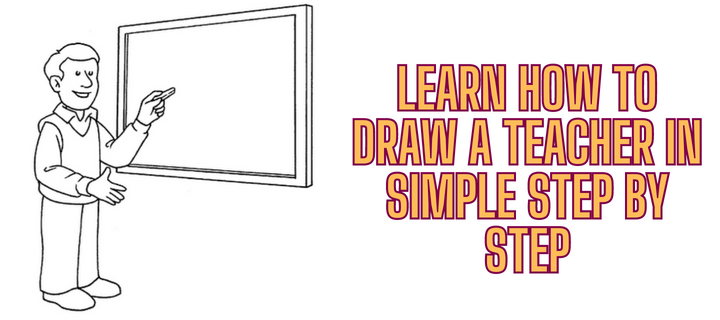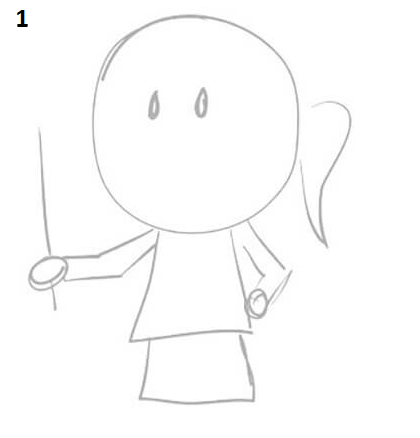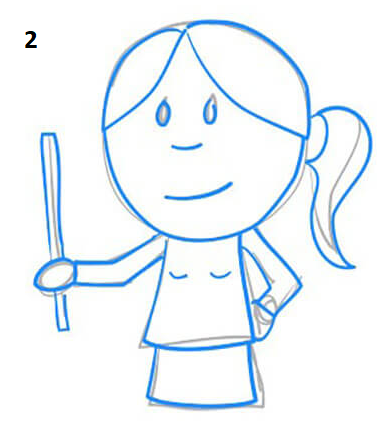Learning to draw is a skill that can provide you with numerous benefits. In this article, we will teach you how to draw a teacher in simple steps, allowing you to improve your artistic skills and expand your creativity. With this tutorial, you can create incredible drawings of teachers and develop techniques that will lead you to master the art of drawing.
How to Draw a Teacher – Why learn to draw a teacher?

Drawing a teacher is not only an excellent way to practice and perfect your artistic skills, but also allows you to capture the essence and personality of an important figure in the educational field. This tutorial will give you the necessary knowledge to represent a teacher in your drawings in realistic or stylized.
What skills will I develop when drawing a teacher?
When learning to draw a teacher, you will develop a series of artistic skills that will serve you for different aspects of your life. Some of the skills you can develop with this tutorial include:
- Improvement of the proportional representation of the human figure;
- Learning shadow techniques and lines;
- Development of the perception of forms and volumes;
- Improve the ability to observe and care for detail;
- Development of your own artistic style.
Materials needed to draw a teacher
Before starting, make sure you have the following materials by hand:
- Drawing paper or notebook with blank sheets.
- Drawing pencils of different hardness (HB, 2b, 4b).
- Delete rubber.
- Sacapuntas.
Step by Step to Draw a Teacher
Follow these simple steps to draw a teacher:

- Start drawing an oval to represent the teacher’s head.
- Add a horizontal line at the bottom of the oval to mark the eye line.
- Draw the eyes, nose and mouth of the teacher using simple lines and shapes.
- Add details such as eyebrows, ears and teacher’s hair.
- Draw the teacher’s neck and shoulders, using soft lines to represent the details of the clothes.
- He continues to draw the rest of the teacher’s body, paying attention to details such as hands and legs.
- Add the final details such as clothes, shoes and accessories of the teacher.
- Finally, review the main contours of the drawing and add soft shadows to give it volume and depth.
Tips and tricks to improve your drawing of a teacher

Here are some tips to improve your teacher representation in your drawings:
- Study photographs or real people to observe specific details such as eyes shape, hair style and facial gestures.
- Practice the use of different drawing pencils to achieve different tones and textures.
- Experiment with different drawing styles, from cartoons to realistic drawing.
- Don’t be afraid to make mistakes. Drawing is a continuous learning process, so have fun and experience.
Common mistakes when drawing a teacher and how to avoid them

When drawing a teacher, it is common to make some mistakes. Here are some common mistakes and how to avoid them:
- Do not pay attention to body proportions. Use guide lines to make sure that all parts of the body are correctly represented.
- Do not add enough shading. The shadow is essential to give volume and depth to the drawing. Try different shading techniques to improve your representation.
- Forget the details. The details are important to give life and personality to your drawing. Pay attention to facial features and details of the clothes.
Other ideas and styles to draw a teacher
In addition to the realistic style, you can also explore other ideas and styles to draw a teacher. Some ideas include:
- Draw the teacher in a cartoon style or comic.
- Create an illustration that represents the teacher in the environment of a classroom.
- Experiment with different drawing techniques, such as point -rash or the use of watercolors.
Inspiration and examples of teachers’ drawings
If you need some inspiration, you can review different works of art that represent teachers. Here are some sources of inspiration:
- Explore art galleries online or in museums.
- Look for drawings of teachers on websites or social networks dedicated to art.
- Investigate illustrations in books or magazines related to education.
Conclusion
Learning to draw a teacher is a fun and rewarding way to improve your artistic skills. It doesn’t matter if you are a beginner or you have experience in the drawing, this tutorial will provide you with the necessary knowledge to represent a teacher realistically or stylized. So take your pencils and start drawing a teacher today!
Frequently Questions
How much time is required to learn to draw a teacher?
The time needed to learn to draw a teacher can vary according to your level of experience and dedication. If you are a beginner, you can take some time to become familiar with the techniques and develop your ability. However, with constant practice, you can master the drawing of a teacher in a short time.
Can I use different drawing techniques to represent a teacher?
Yes, you can definitely use different drawing techniques to represent a teacher. You can experiment with colored pencils, watercolors, ink or even digital techniques. The choice of technique will depend on your personal preferences and the style you want to achieve.
Is it necessary to have previous skills in drawing to try this tutorial?
It is not necessary to have previous skills in drawing to try this tutorial. This step by step is designed for beginners and offers simple instructions that will allow you to create a basic drawing of a teacher. With time and practice, you can improve and develop more advanced skills.
Where can I find visual references from teachers to inspire me?
You can find visual references of teachers in a variety of sources. Some options include searching in textbooks, online images, photographs of real people or even taking as a reference to your own teachers. The key is to use these references to capture the essence and personality of a teacher in your drawing.
